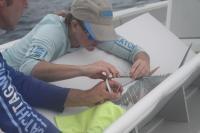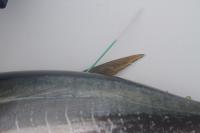Recovering Tuna Tags is Rewarding in More Ways Than One
Editor’s Note: Today’s feature comes to us courtesy of the Louisiana Department of Wildlife and Fisheries.
from The Fishing Wire
If you reel in a big one, you might catch more than just a trophy fish for dinner
The Louisiana Department of Wildlife and Fisheries is actively implementing a research program that involves the insertion of electronic tracking devices in yellowfin tuna to better understand their behavior. Fish tagging programs are typically designed by scientists, but any angler can contribute to this important research.
LDWF biologist Jennifer McKinney performs surgery on a yellowfin tuna to insert an internal archival tag.The most important action that anglers can take to aid tagging programs is to return tags and information. In order for the Department to learn more about yellowfin tuna movements and habitat use in the Gulf of Mexico, biologists are requesting anglers return the internal archival tags when a tagged fish is caught.
“The holy grail of these electronic tags is the detailed data they record,” explained LDWF Assistant Secretary Randy Pausina. “But LDWF researchers can only access that level of information if they get the tag back.”
Not only can anglers expect a better-managed fishery, but the department is also offering up a reward for every tag returned. Individuals who return an intact electronic tag will receive a $200 Academy Sports and Outdoors gift card.
Tuna included in this study are surgically implanted with an electronic tag in the abdominal cavity and can be identified by an external green and white conventional tag at the base of the second dorsal fin.If you catch a tagged yellowfin tuna:
• Record date, time and catch location (GPS coordinates).
• Measure fork length, weight and take photos of the surgical site (when possible).
• Carefully remove the tag from the fish. The light stalk, which can be seen protruding from the abdomen of the fish, must remain connected with the tag body inside the fish.
• Call the reward line at (855) 728-8247 or email sattag@wlf.la.gov to arrange pickup of the tag.
The internal archival tags are surgically implanted into the belly of the fish and record a range of parameters every 30 seconds including depth, light intensity, water temperature and the internal body temperature of the tagged tuna.
Since the study began in June 2013, over 100 internal tags have been deployed with approximately a 10% recapture rate. Thus far, the greatest movement of an internally tagged yellowfin is 155 nautical miles after 417 days at large.
The department will continue the study over the next few years, and resulting data can indicate habitat preferences and feeding and spawning behavior. Findings will greatly improve the body of knowledge of the yellowfin tuna resource in the Gulf of Mexico and its connectivity with the Atlantic-wide population, resulting in improved stock assessments and fishery management.
The Department of Wildlife and Fisheries is charged with managing and protecting Louisiana’s abundant natural resources. For more information, visit us at www.wlf.la.gov, on Facebook at www.facebook.com/ldwffb or follow us on Twitter @LDWF.

